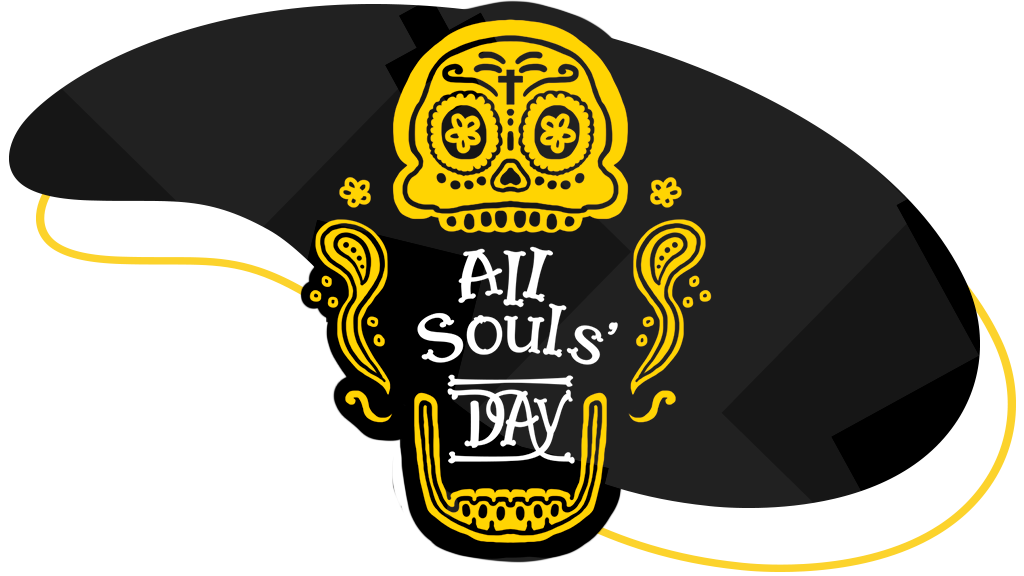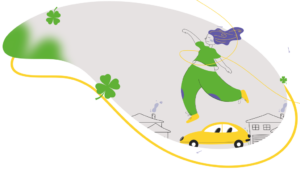As we learned in our Halloween blog post, the name “Halloween” actually originated from the term ALL- HALLOWS-EVE, which is day before— eve— of All Saints’ Day. The next day is All Souls’ Day and in the same time frame is Mexico’s Día de los Muertos.
What is the connection between these four dates? You’ve got questions and we’ve got answers. Keep reading to find out!
Dia de los Muertos
If you’ve watched Coco (or Viva, in Brazil) you might have some idea of what this day is all about. If you haven’t, consider this another Breezy Seguros movie tip!
The Day of the Dead (El Día de los Muertos) is a Mexican holiday where families receive back the souls of their deceased relatives for a brief reunion. For this reunion, families prepare an altar at home or wherever the relative is buried. This altar is covered with photos, incense, candles, sugar skulls, and with the favorite foods and drinks of all their deceased loved ones. Every item placed on the altar has a meaning and a purpose, and the celebrations include music.
According to tradition, the gates of heaven open at midnight on the 31st of October, when the spirits of children can gather with their families for 24 hours. The same goes for adult spirits on November 2nd. During those days, people will celebrate by wearing skull masks and eating skull-shaped foods.
The festivals on this day are a mixture of many cultures that influence Mexican culture, including native peoples, European religion and Spanish culture. The festivities run from October 31st to November 2nd. The first is on Halloween, called “el Día de los Inocentes”, or Children’s Day. This is followed by “All Saints Day” on the first of November, and then “Día de los Muertos” or Day of the Dead on November 2nd.
Since 2008, when UNESCO added Mexico’s “Indigenous Feast dedicated to the Dead” to its list of Intangible Cultural Heritage of Humanity, the Day of the Dead was established as a traditional celebration throughout Mexico. Initially limited to rural areas of the country, the trend began to spread to cities in the 1980s.
It eventually gained traction in the US, where there is a large population of Mexicans and Mexican descendants. For example, Boston has an official celebration of Día de los Muertos.
These rituals have taken place in Mexican civilization for at least 3,000 years.
ALL SAINTS’ DAY
The origin of the Catholic date of All Saints’ Day is often confused with the origin of Halloween. With the Roman Empire’s invasion of Celtic land, the Church was exposed to pagan rituals and several popes attempted to replace them with Catholic holidays.
The commemoration dates from 609 or 610, the date on which Pope Boniface IV dedicated the Pantheon to Mary and all the martyrs. The date initially honored the martyrs, the saints who died as heroes in the name of the Church. It would come to be known as All Saints’ Day.
In 1000 AD, the church made November 2 All Souls’ Day, a day to honor the dead and replace the Celtic date. All Saints’ Day was set for November 1st.
Contrary to the church, the celebration of Samhain continued to take place the day before, on October 31st. This day was then renamed ALL-HALLOWS-EVE (all = all, hallows = saints, eve = eve, the eve of All Saints’ Day) and would eventually become known as HALLOWEEN.
ALL SOULS’ DAY
All Souls’ Day, also known as the Day of the Faithfully Departed, is an almost inherent human tradition. It is the day to honor the dead and pray for their souls.
Praying for the deceased has been a part of Christian customs since the 2nd century, when it was common to visit the tombs of the martyrs. In the fifth century, the Church dedicated one day of the year to pray for all the already forgotten dead. Abbot Odilo de Cluny, at the end of the 10th century, asked the monks to pray for the dead. In the year 732, Pope Gregory III authorized priests to hold masses in memory of the deceased. But it is only in the 13th century that the date was made official on November 2nd.
If you pass by an old church, you will likely see a cemetery on the grounds. The community was in constant contact with headstones, which represented their departed ones.
This reinforced the concept of the Church as a pilgrim community (the living), suffering (the souls being purified in Purgatory) and triumphant (the holy souls in Paradise). If All Saints’ Day celebrated the triumphant ones, All Souls’ Day honored the souls in Purgatory, for whom prayers and sacrifices were offered.
From the 15th century onwards, the holiday spread all over the world. Every part of the world celebrates this date in its own way. In Mexico, for example, it is associated with the “Día de los Muertos” which unites the Catholic celebration with ancient Aztec rituals. In Brazil, the tradition is to go to cemeteries, take flowers, light candles and pray for loved ones who have died.
AUTUMN FESTIVALS
All these dates have a similar origin with coinciding moments in history, and all include ancient customs from their ancestors.
These festivals, which take place in autumn, feature symbols that represent the renewal and rebirth of nature. They began with the understanding that death exists so that life can continue.
These festivals, in addition to sharing the same days, honor the dead and the evolution of the spirit. It can be frightening like Halloween, animated like Día de los Muertos or sad like All Souls’ Day. What is important to remember about all of them is that death teaches us to honor those who are gone and to value the cyclical process of life-death-life.








